The Economics and Statistics Division maintains archives of previous publications for accountability purposes, but makes no updates to keep these documents current with the latest data revisions from Statistics Canada. As a result, information in older documents may not be accurate. Please exercise caution when referring to older documents. For the latest information and historical data, please contact the individual listed to the right.
<--- Return to Archive
For additional information relating to this article, please contact:
November 09, 2022POPULATION: CENSUS FAMILIES AND MARITAL STATUS FOR JULY 1, 2022 Statistics Canada has released revised estimates about census families and marital status as of July 1, 2022. This reflects the recent population estimate of 1,019,725 as of July 1, 2022.
Census families
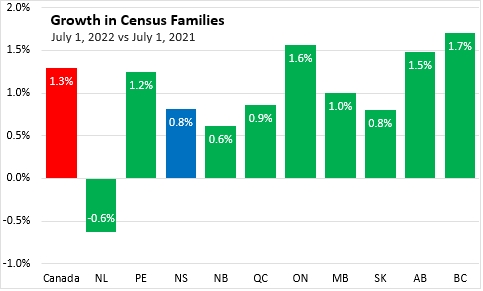
The number of census families in Nova Scotia increased by 0.8% from July 1, 2021 to July 1, 2022, reaching 284,408 families. The growth in the number of census families was notably slower than the 2.89% increase in the total population over this period.
Across Canada, the number of census families increased by 1.3% with faster growth in British Columbia, Ontario and Alberta. Only Newfoundland and Labrador reported a decline in the number of census families.
In all provinces, growth in lone parent families outpaced growth in couple census families.
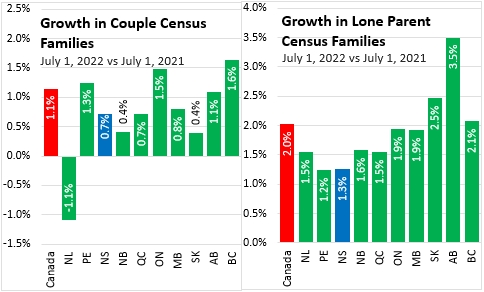
Of the 284,408 census families in Nova Scotia there were 231,805 couples census families and 52,603 lone parent families. Nova Scotia had the second highest share of lone parents among census families (18.5%) after Saskatchewan (20.0%). British Columbia (15.5%) had the lowest portion of lone parents among census families.
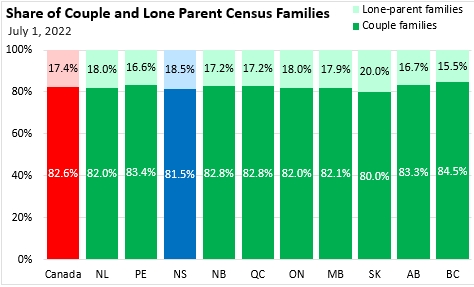
Nova Scotia used to have the hightest portion of lone parents among census families, but in the last five years, there has been a notable rise in the share of lone parents among Saskatchewan census families. Although lower than Saskatchewan and Nova Scotia, the share of lone parent families has been rising faster in recent years for Newfoundland and Labrador as well as Alberta.

Growth in the number of Nova Scotia census families accelerated starting in 2015, at the same time as the province's overall population growth started to rise more quickly (+4.6% from 2015 to 2022). However, Nova Scotia's growth in census families since 2006 remains slower than in all provinces except Newfoundland and Labrador and New Brunswick.
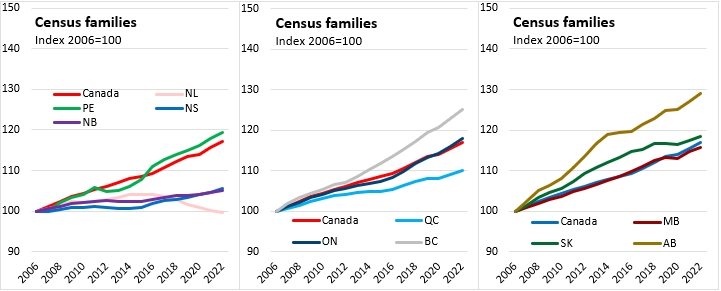
Growth in the number of couple families has accelerated in Nova Scotia since 2015 (+3.8% from 2015 to 2022), but over this period the pace of growth lags all other provinces except Newfoundland and Labrador, New Brunswick and Saskatchewan.
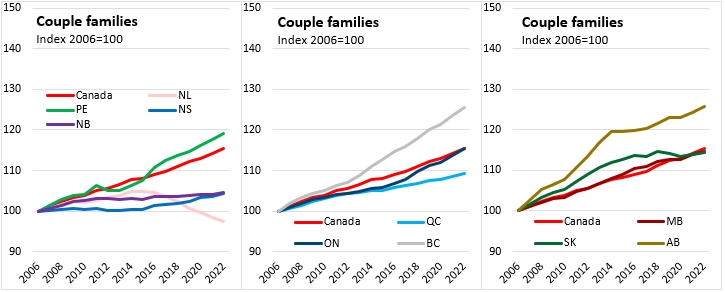
Since 2015, the number of lone parent families in Nova Scotia was up 8.2%, but this was slower than growth of lone parent families in all other provinces.

Notes: Statistics Canada defines a census family as a married couple (with or without children of either and/or both spouses), a common-law couple (with or without children of either and/or both partners) or a lone parent of any marital status, with at least one child. A couple may be of opposite sex or same sex. Note that this definition excludes unattached individuals and thus is not equal to the number of households.
Marital Status
The population can be broken down into six categories of marital status: single, married, separated, living common-law, widowed and divorced.
Of the 1,019,725 residents estimated for Nova Scotia as of July 1, 2022 the largest numbers were either married (397,734) or single (383,841). Note that this includes all ages, so younger residents are all counted as 'single'. There were a further 96,549 persons living in a common-law arrangement. There were 59,697 widowed Nova Scotians, a disproportionate number of whom were women. There were 28,477 Nova Scotians who were separated and 53,427 who were divorced.
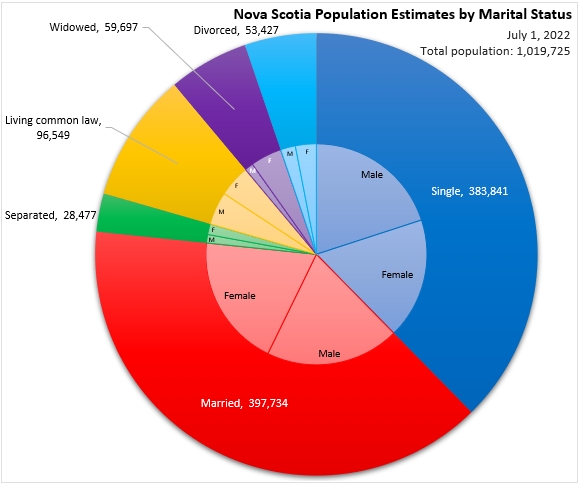
Martial status is variable by age - with younger adult populations reporting a higher proportion who are single or living in a common law arrangement. Between the ages of 30 and 80, the bulk of the population is married or living in a common-law arrangement, though for older members of this age cohort there are fewer living in common law arrangements, more living as married couples and a higher portion who are divorced. Older populations (particularly those aged 80 and over) report higher shares who are widowed and smaller portions of those who are married.

Compared with the national average, a lower portion of Nova Scotia's population is single or living in a common-law arrangement while higher proportions are married, separated or widowed. This is consistent with Nova Scotia's older demographic profile.

Over time, propensities for married status have changed across age cohorts. From 1992 to 2022, there was a rise in the share of non-senior cohorts who were single, though the share of single individuals among older cohorts (65+) has declined. There has been a rising share of the population living in common law arrangements across all cohorts, but this still makes up a relatively small portion of the population at each age cohort.
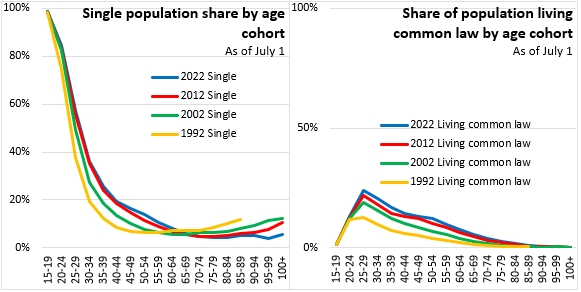
There has also been a decline in the share of non-senior cohorts who are married. For example, in 1992 62.5% of the population aged 30-34 was married but by 2022, the share of the population aged 30-34 who were married had fallen to 38.5%. Although the share of the population who are widowed rises consistently with age, the share of the population in age cohorts from 50 to 89 years old who are widowed has been falling.
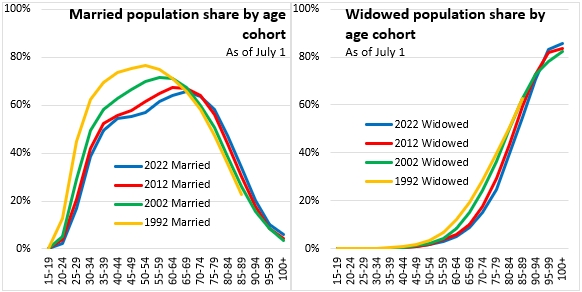
The share of the population who are separated or divorced is comparatively small, but there have been notable changes over time. In 2022, Nova Scotians under age 35 are less likely to be separated than those of similar ages in previous years, but those over age 40 were more likely to be separated than in previous years. Likewise, the share of Nova Scotians in 2022 who were divorced has fallen for younger populations (under age 50), but increased for older populations (aged 50+).

Source: Statistics Canada. Table 17-10-0061-01 Estimates of the number of census families as of July 1st; Table 17-10-0060-01 Estimates of population as of July 1st, by marital status or legal marital status, age and sex
<--- Return to Archive